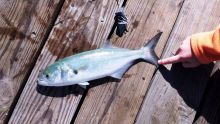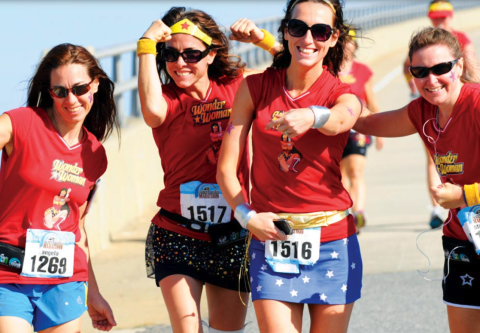
The Outer Banks is one of the best places in the world to fish. A wide variety of fish are out there swimming in the ocean and sounds, even in a few lakes, ponds and creeks, and there are many people out there who are willing to help you catch them.
On the Outer Banks you can choose from head boats, offshore charters, inshore charters, surf fishing, fly fishing, pier fishing, inshore wading, kayak fishing, spear fishing, wreck fishing or private guides and charters. Tackle shops are found in great abundance on these islands, and the people who work in them are very cooperative and helpful.
Photo: Jennette's Pier, Facebook
Fishing Licenses
All saltwater anglers are required to buy the N.C. Coastal Recreational Fishing License. The license can be purchased on a 10-day, annual or lifetime basis or combined with other licenses issued by the Wildlife Resources Commission. Children younger than 16 do not need a license. For-hire vessels and ocean fishing piers have the option to purchase a blanket license that covers all their fishing patrons, but be sure to ask. Freshwater fishing requires a Freshwater Fishing License. Licenses can be purchased online at www.ncwildlife.org, by calling (888) 248-6834 or at many of the local tackle shops.
Recreational Possession and Size Limits
For some fish, the N.C. Division of Marine Fisheries limits the size and amount you can harvest. The laws change frequently and are a little confusing to keep track of, but ignorance is not a valid reason for breaking them. Local tackle shops have all the information you need about bag and size limits, or you can see the limits online at http://portal.ncdenr.org/web/mf/. And remember, it’s just good sportsmanship to never take more fish than you can use. Release any fish you won’t be able to eat.
Tackle & Bait
Knowing which rod and reel, fishing line, rig and bait to use is a complicated science.
There are different rods and reels for different kinds of fishing, the most common being surf-casting rods, trolling rods, light-tackle spinning rods and fly rods along with bait-casting (open-face) reels, spinning reels and fly reels.
There are also several kinds of hooks and rigs. One of the most commonly used for inshore fishing and pier fishing is the bottom rig, which is weighted so that it sits on the bottom while the bait dangles above it. If you are using a bottom rig, get a few different weights because the amount you’ll need will vary depending on the amount of current flowing where you’re fishing.
Even fishing line requires decision making. Fishing line comes in pound test increments, which essentially means the amount of tension the line can bear before it breaks.
Bait brings a whole set of issues. Should you use live bait, fresh bait, frozen bait or an artificial lure? It depends. Live bait works best, but it’s the most expensive and difficult to maintain when you’re out fishing. Fresh bait, like shrimp or cut mullet, is the next best, then frozen, such as squid or shrimp. Artificial lures require a little more technique, but they’re always at the ready and don’t rot in the sun.
If you are a novice, the best thing to do is to consult a tackle shop for advice on what to use, or to contact a local fishing instructor or guide. Tell them the ages of your fishing party and give them a general idea of the type of fishing you’d like to do, e.g., fishing on the beach or from a pier or perhaps fishing from a kayak in the sound. They’ll help you decide what type of rod, reel, line, hooks and bait you’ll need. Many tackle shops and piers also rent tackle so if you don’t want to invest in gear you’ll only use once a year, this is a good way to go
Outer Banks Offshore Charter Fishing
Outer Banks offshore charter fishing is the big-time fishing this area is known for. Offshore fishing means heading out to sea to the Gulf Stream, where giant species of fish like billfish, tuna and dolphin lurk. Outer Banks offshore charter boats are big business, and most command between $1,800 to $2,000 a day plus a tip for the mate. However, the boats can take up to six anglers per trip, so if you divide the cost among six people it doesn’t seem so outrageous. Because the journey to the Gulf Stream is an hour or more, offshore charters last a full day, starting at around 5 a.m. All you need to bring is food, drinks, sunscreen and seasickness remedies; the captain and mate supply everything else and offer any instruction you need. You can book an offshore charter through one of the local marinas. Charter fishing boats are located close to the inlets for easy access to the ocean; since there are no inlets on the northern Outer Banks there are no charter fishing boats there either. Fish-cleaning services are offered at each marina.
Inshore Charters
If you really want to increase your odds of catching a fish, it pays to hire a guide. These are people who are out on the water every day, and they know where the fish are and how to catch them. Inshore guides typically fish in the sounds, inlets or nearshore waters and offer light-tackle or fly fishing trips. They’ll take you out for a half-day or a full day. You can find an inshore guide through a tackle shop or a marina. If you’re new to Outer Banks fishing, tell that to the booking agent and they’ll recommend a guide who is skilled at instructing new anglers.
Marinas
The following marinas book inshore and/or offshore charters.
Pirate’s Cove Marina, Manteo, (252) 473-3906
OBX Marina, Wanchese, (252) 473-5344
Oregon Inlet Fishing Center, just south of Nags Head, (252) 441-6301
Oden’s Dock, Hatteras Village, (252) 986-2555
Hatteras Harbor Marina, Hatteras Village, (252) 986-2166
Village Marina, Hatteras Village, (252) 986-2522
Hatteras Landing Marina, Hatteras Village, (252) 986-2077
Head Boat Fishing
Head boats are large boats that take out a lot of people at once, and they provide all the bait and tackle, plus a helpful mate. Head boats take passengers on bottom-fishing trips either in the sound or in the near-shore ocean waters and wrecks and are great for kids because there are restrooms and snacks onboard and they offer half-day trips.
Crystal Dawn, Pirate’s Cove Marina, Manteo, (252) 473-5577
Miss Oregon Inlet, Oregon Inlet Fishing Center, South of Nags Head, (252) 441-6301
Miss Hatteras, Oden’s Dock, Hatteras Village, (252) 986-2365
Surf Fishing
The Outer Banks has more than 100 miles of beach on which you can cast a line. All you need is a fishing license, surf rod and rod holder, a cooler and some bait. If you are using frozen bait, be sure to bring a cooler to keep it cold and prevent the birds from nabbing it. You may also want to use a rod holder; that way you’ll never have to lay your rod and reel down in the sand. In the cooler months, you’ll want to wear waders or hip boots. Surf anglers with four-wheel-drive vehicles can drive on the beach in certain areas of Cape Hatteras National Seashore on Hatteras and Ocracoke islands, but keep in mind that a beach-driving license is required. This makes it really easy to get all your gear to the beach and find the best spot. You get a license and can pick up an Off-Road Driving Map at any of the National Park Service visitor centers. Click here for the most up-to-date information. You can also drive on the beach north of Corolla year round and in Nags Head and Kill Devil Hills in the winter months, with a permit from the town; click here for more info.
Tides, Winds and Time
The bite is definitely affected by tide, wind direction and time of day. Again, ask at your chosen tackle shop about the best tides, times and wind/weather conditions for your chosen type of fishing. If it seems like too much to keep track of, don’t worry about it and just go out and have fun! Often, if you stay out long enough, the conditions will line up at some point and you’ll catch something.
Piers
A pier can get you out into the deep-water fishing grounds for an inexpensive price and without the hassle of a boat. There are several piers along the Outer Banks, and they all have bait and tackle shops. Some of the shops rent fishing gear so you don’t have to go out and buy it. All of the pier-house staffs offer expert advice on what’s biting and how to catch it.
Avalon Fishing Pier, Kill Devil Hills, (252) 441-7494
Nags Head Fishing Pier, Nags Head, (252) 441-5141
Jennette’s Pier, Nags Head; (252) 255-1501
Outer Banks Fishing Pier, South Nags Head, (252) 441-5740
Rodanthe Pier, Rodanthe, (252) 987-0030
Avon Fishing Pier, Avon, (252) 995-5480
Bridges
Many species of fish are attracted to structure, which is why you often see anglers hanging around bridge pilings. If you have access to a boat, it’s easy to motor up to any bridge pilings to fish. But even without a boat, you can still access some bridges.
Herbert Bonner Bridge — On the southern end of the Herbert Bonner Bridge over Oregon Inlet is a “catwalk,” a dedicated fishing walkway that is separate from the roadway and therefore safe for anglers. Park in the lot on the southern end of the bridge.
Washington Baum Bridge — This bridge spans the channel between Roanoke Island and Nags Head. Underneath the west end is a nice pier and dock. The access area and parking lot is just across the street from Pirate’s Cove Marina.
Nags Head-Manteo Causeway Bridge — Also known as “The Little Bridge,” this bridge has side walkways that make it easy for anglers to fish in the Roanoke Sound. It’s a good fishing spot and is often crowded with anglers.
Commonly Caught Fish on the Outer Banks
Surf
Bluefish, drum, spot, flounder, croaker, pompano, striped bass, sea mullet, Spanish mackerel
Sound
Striped bass, speckled trout, drum, flounder, croaker, spot, pinfish
Bridges
Striped bass, croaker, sheepshead, spot, black drum, trout
Piers
Croaker, Spanish mackerel, bluefish, spot, sheepshead, cobia, flounder, croaker
Off-shore
Blue marlin, white marlin, sailfish, yellow-fin tuna, blackfin tuna, dolphin (mahi-mahi), wahoo, cobia

 Molly Harrison is managing editor at OneBoat, publisher of OuterBanksThisWeek.com. She moved to Nags Head in 1994 and since then has made her living writing articles and creating publications about the people, places and culture of the Outer Banks.
Molly Harrison is managing editor at OneBoat, publisher of OuterBanksThisWeek.com. She moved to Nags Head in 1994 and since then has made her living writing articles and creating publications about the people, places and culture of the Outer Banks.




